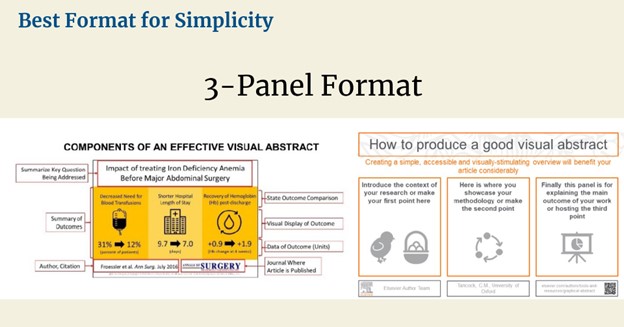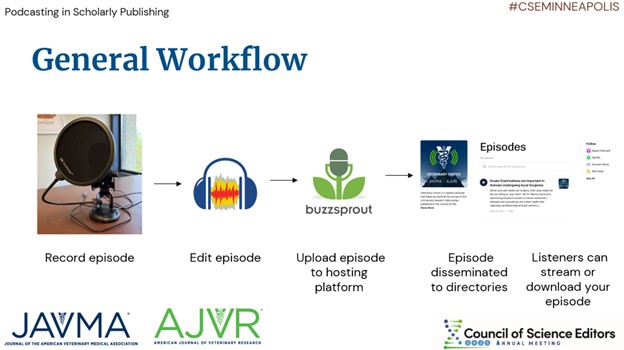MODERATOR:
Sarah E Wright
American Veterinary Medical Association
SPEAKERS:
Emilie Gunn
American Society of Clinical Oncology
Claire Neumann
American College of Gastroenterology
Meredith Pond
BioOne
REPORTER:
Jessica McEwan
Entomological Society of America
As most CSE members can attest, science is under pressure from misinformation and seismic changes in political priorities. And, while most of our publishing activities focus on the specialists and practitioners in our specific fields, having the tools to communicate important findings to a wider audience has never been more important.
Following the awards luncheon on the final day of the conference, Sarah E Wright of the American Veterinary Medical Association moderated a session titled “Increasing Article Reach Off the Page: Promoting Scientific Research to a Wider Audience.” The speakers covered three methods to increase audience reach, with a bonus communication tool described by the moderator at the end.
First, Claire Neumann of the American College of Gastroenterology introduced the concept of the visual abstract (VA), a pictorial representation of the main findings or most important message of an article. She provided a brief history of VAs, starting in the 1970s with multi-language journals and ending with founding Creative Director of Annals of Surgery Dr Andrew M Ibrahim’s Visual Abstract Primer in 2016.1
Neumann explained that a VA has the power to maximize an article’s usability on social media, since they are sized for sharing on LinkedIn, BlueSky, and other social media platforms. She also described the ideal “3-Panel Format” for simplicity. This structured format introduces the context or first point within the first third of the VA, the methodology or second point in the center, and explains the main outcomes or the final point on the right (Figure 1).

Neumann described several hurdles involved in adopting VAs, explaining that since the VA is primarily a tool that promotes the full article, editors should take care to avoid generating overly positive images that leave out important limitations or null outcomes. Since VAs are consumed quickly, editors should also be careful not to develop overly complicated or cluttered VAs that obscure the meaning. The time and cost of creating and reviewing VAs, as well as how copyright applies to the overall VA and the included images and information, must also be considered.
Next, Emilie Gunn of the American Society of Clinical Oncology discussed plain language summaries (PLS), which as the name suggests, are concise article summaries that cut out the jargon and use concise sentences to convey the most important points. Emilie stressed the importance of knowing and tailoring the PLS to the targeted audience, whether it be nonspecialist physicians, those for whom English is not the first language, reporters, or the public.2
Gunn provided interesting information regarding the effectiveness of PLS, citing one hematology study that found the required reading level for the average PLS was university level or no different than the article itself. She suggested that the author of an article may not be the best person to write a summary, since their deep knowledge of the research may make it difficult for them to distill it to the level needed. Before getting started with a PLS program, editors should identify the intended audience, decide who will write the summaries, what will be included, if a template will be used and whether the PLS will be part of the article or standalone.
The final speaker was Meredith Pond of BioOne. Pond explained that early-career author awards help researchers build their professional profiles, increase a journal’s visibility and impact, and demonstrate an organization’s commitment to supporting emerging voices. Celebrating an author’s achievements, Pond explained, allows the organization to foster stronger relationships with authors while reinforcing its reputation as a champion of the good work done by scientists.
Once she finished explaining the benefits of an awards program generally, Pond described BioOne’s Ambassador Award, which rewards authors who demonstrate talent in translating their research to plain language. Nominees are asked to submit a response to the question “How does your research change the world?” Pond covered the rich and creative ways that researchers can discuss the impact of their findings [from written essays to video] to bring science to a diverse audience. This was a great segue for moderator Sarah Wright to return to the podium to describe her BioOne Ambassador winning work and podcasting for the American Veterinary Medical Association.
Wright’s passion for coaching authors on communicating their science through podcasting was evident as she spoke. She explained that it is especially impactful for an audience to hear directly from a researcher about their work. In addition to providing practical advice about the things that need to be in place to record a podcast, like subscribing to a hosting platform, writing an episode and drafting questions for interviewees, creating social media accounts, and obtaining needed equipment, she presented a slide of the general podcast workflow (Figure 2).

As with all the communication media presented in this session, Wright stressed the importance of setting a goal and knowing your intended audience. When she helps an interviewee prepare for a podcast, she often asks them how their research findings will advance veterinary medicine or the clinical relevance of their work, so they can focus on communicating that message clearly. As a final thought, she warned attendees to be thoughtful about advertising and avoid pairing a podcast with ads for a relevant product or service.
For me, this was one of the most interesting sessions at CSE. I appreciated that the speakers provided their own real-world experience with audience expanding communication tools: VAs, PLS, awards, and podcasts. Their practical advice included similar takeaways: know your audience, adapt the communication for that audience, and think strategically about who is best suited to prepare and deliver the message. In some instances, the audience may benefit from hearing directly from the author and in others, the author may not be best equipped to distill their research and cut out the jargon. Thoughtful planning and learning from fellow CSE members can make adopting these methods easier and more effective.
References and Links
- Ibrahim AM. A primer on how to create a visual abstract. [accessed August 15, 2025]. 2016. https://www.SurgeryRedesign.com/resources.
- Wissing MD, Porter AC, Tanikella SA, Kaur P, Cornfield LJ, D’Cruz SC, Tomlin HR, Capasso-Harris H, Tabas L. Evaluation of use of medical terminology and interpretation of results in oncology plain language summaries. In: Original abstract from the 19th Annual Meeting of ISMPP. Curr Med Res Opin. 2023;39(supp 1):S19. https://doi.org/10.1080/03007995.2023.2194075.
